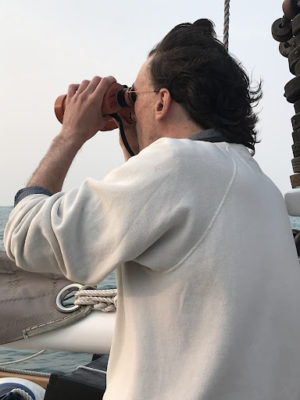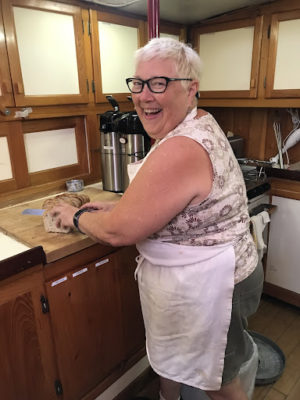On our six-day transit from Detroit to Houghton, fifteen volunteers and staff members were aboard the schooner Inland Seas. For these sailors, this voyage is not an opportunity to just sit back and enjoy the ride. Each person on board the ship has a role with daily responsibilities and duties to perform. Let’s take a look at what each role entails.
Captain

What comes to mind when you think of a captain? Barking orders at sailors? Standing behind the wheel steering the vessel? The responsibilities of the captain goes far beyond that. The captain is accountable for the safety of the ship and all the people on board. She assumes the role of supervisor, so while she does not physically complete each task on the ship, it is her responsibility to ensure that they are all completed. Having a hierarchy that includes a mate and watch leaders allows the captain some time for rest, but there are many conditions that require waking her up. For example, if a vessel is spotted within a certain range of the ship at night, the captain needs to be on deck to decide the safest course. The captain is on duty anytime the ship is passing through a tight channel or waterway regardless of how long that takes. Lily Heyns, the relief captain for Inland Seas, explains “It can be difficult to let go, but it is all about having faith in your watch officers. That faith is well-earned as I need to trust that they will wake me up and not try to take charge of situations. I actually sleep better when I am woken up more often.”
The captain is also responsible for navigation so she chooses the course and relays that to the crew. In addition to paper charts, the ship is equipped with a GPS system. These physical and digital charts are used to determine the most efficient course that is still safe so the captain keeps water depth and potential hazards in mind when making decisions. She also routinely records the ship’s position and course in a log so that if electronics malfunction, she can estimate current position without being reliant on modern technology.
Lastly, the captain is responsible for managing crew resources. This refers to physical resources, but also checking in to see how the crew is doing physically, mentally, and emotionally. The captain wants to provide ample learning experiences for each crew member without putting them in situations they cannot handle. Therefore, the captain’s responsibilities are far beyond what is immediately visible. As Lily remarks, “The role of captain requires constant and dedicated attention. I’m always paying attention to and thinking about multiple things. Honestly, the captain is never not paying attention.” Still think captains just yell out orders?
Crew
 The crew on our schooner is composed of everyone on the vessel: volunteers, educators, and interns. Everyone is placed into a watch group that rotates throughout the day and night. When on duty, crew members might be stationed on bow watch which entails looking for other vessels and identifying channel markers like colored buoys. Crew will also be asked to complete hourly boat checks which involves checking bilges for water accumulation and taking readings like battery power, RPM, oil pressure, or reefer temperatures. On-duty crew might be stationed at the helm to steer the schooner and change course per the captain’s instructions.
The crew on our schooner is composed of everyone on the vessel: volunteers, educators, and interns. Everyone is placed into a watch group that rotates throughout the day and night. When on duty, crew members might be stationed on bow watch which entails looking for other vessels and identifying channel markers like colored buoys. Crew will also be asked to complete hourly boat checks which involves checking bilges for water accumulation and taking readings like battery power, RPM, oil pressure, or reefer temperatures. On-duty crew might be stationed at the helm to steer the schooner and change course per the captain’s instructions.
The crew is responsible for the cleanliness and organization of their own bunks, as well as shared living spaces. Routine cleaning is performed by the crew and is termed “soles and bowls” as it involves sweeping and mopping the soles (floors), as well as cleaning the head (bathroom). As needed, the crew helps in the galley with tasks such as food preparation, and everyone is responsible for washing their own dishes after each meal.
Lastly, the crew performs many tasks related to sailing and docking as needed. This includes raising the sails, giving slack to or tightening lines to alter the ship’s course, and sending lines to shore when docking.
Cook
Have you ever seen a galley (the crew will kindly remind you of this terminology if you ever use the word “kitchen” on the ship)? If not, imagine a miniature version of your kitchen, still equipped with a sink, oven, stovetop, etc. Now, picture a steel mast running through your countertop, your coffee pot bungeed in place, your fridge (called a reefer) opening via trap doors on the counters, and a gimbaled stove that tilts with the motion of the ship. A little different than the kitchen in your home, right?

The cook on board is responsible for preparing three meals a day, and during a long transit, these meals are staggered to accommodate for crew coming on and off watch. Cooking on board comes with many challenges as appliances operate differently and the number of crew members to feed changes at each port. This season’s cook, Jeannie Inglehart, recalls being halfway through preparing lunch when she ran out of propane. She had to turn off all the burners and run up on deck to change the tank.
Jeannie cooked for ISEA in 2008 and came prepared this year with many tips and tricks to overcome these challenges. For example, she brought a pizza stone on board which helps regulate the temperature of the oven and even out the heat. She plans to gift this item to ISEA at the end of the season. Jeannie made homemade biscuits and loaves of bread from scratch, something I can’t do even when my kitchen is not floating in the middle of a lake! Cooking while the ship is tossing in the waves can also be challenging, but Jeannie humorously remarks, “I always dance in the kitchen, so when the ship is rocking, my feet are constantly moving anyway.” I think anyone can be successful cooking in the galley with sufficient planning and a positive attitude because, as Jeanie explains, “sailors are out working hard in the heat so they’re a joy to feed because they’re always hungry!”
ISEA hires a mate and cook each season and always accepts new volunteer instructors and crew in training. Sailing with us is a truly unique and rewarding experience and provides ample opportunities to learn, gain skills, and make memories. Think this could be you?
This blog was written by Christina Javorka, 2021 Marketing and Communications Summer Intern for Inland Seas Education Association. Christina is studying marketing and fashion retail at The Ohio State University. Being from the Chicagoland area, Lake Michigan holds a special place in her heart. Her favorite thing about the Great Lakes is finding the treasures hidden within and telling others about them.